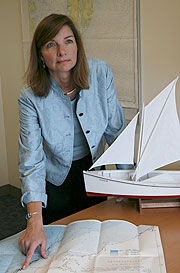Empowering Learners With Personalized Microcredentials, Stackable Badges
The University is enhancing its commitment to lifelong learning with digital badges, a tool that recognizes and authenticates the completion of microcredentials. The badges aim to support learners in their professional and personal development by showcasing achievements in short, focused…

 Mariners call the continental margin off the North Carolina coast the “graveyard of the Atlantic.” Syracuse University’s first Professor of Interdisciplinary Sciences, Cathryn R. Newton, sees the area as rich with fossils for paleontologists, marine archeologists and historians to study.
Mariners call the continental margin off the North Carolina coast the “graveyard of the Atlantic.” Syracuse University’s first Professor of Interdisciplinary Sciences, Cathryn R. Newton, sees the area as rich with fossils for paleontologists, marine archeologists and historians to study.